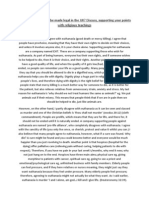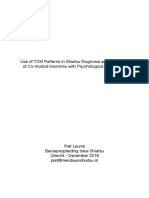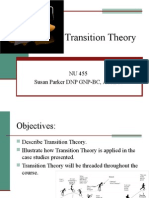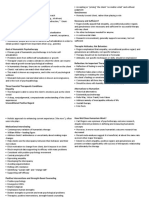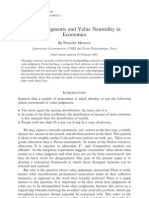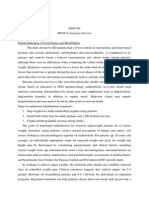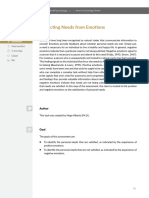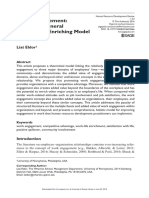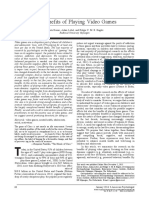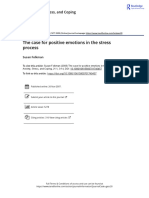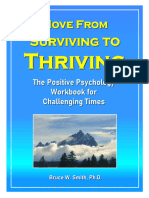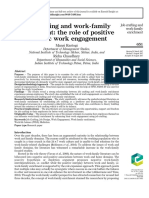Positive Thinking in Coping Stress and Health Outcomes
Positive Thinking in Coping Stress and Health Outcomes
Uploaded by
defour_n4Copyright:
Available Formats
Positive Thinking in Coping Stress and Health Outcomes
Positive Thinking in Coping Stress and Health Outcomes
Uploaded by
defour_n4Original Description:
Copyright
Available Formats
Share this document
Did you find this document useful?
Is this content inappropriate?
Copyright:
Available Formats
Positive Thinking in Coping Stress and Health Outcomes
Positive Thinking in Coping Stress and Health Outcomes
Uploaded by
defour_n4Copyright:
Available Formats
Journal of Research and Reflections in Education
June 2010, Vol.4, No.1, pp 42 -61
http://www.ue.edu.pk/jrre
Positive Thinking in Coping with Stress and Health outcomes:
Literature Review
Zarghuna Naseem & Ruhi Khalid
Abstract: This article reviews literature on positive thinking and its
effect on the appraisal of stress, coping and health outcomes. Positive
psychology is a new dimension that focuses on positive thinking,
positive emotions and positive behavioral qualities that enhance human
potential in various domains such as work, coping with stress and
health. By thinking positively, we perceive the stress as less
threatening, are able to cope with it effectively. Fredricksons broaden
and build theory of positive emotions was the theoretical framework for
this article. Papers studying positive thinking, positive emotions,
optimism, hope and wellbeing were included in the review. The
implications for counselors, educationists and the community at large
have also been discussed.
Keywords: positive thinking, positive emotions, optimism, stress,
coping and health
Introduction
This paper is an attempt to review the literature on positive thinking and its
effect on stress appraisal, coping and health outcomes. Positive thinking is looking at the
brighter side of situations, making a person constructive & creative. Positive thinking is
related with positive emotions and other constructs such as optimism, hope, joy and
wellbeing. McGrath (2004) defined positive thinking as a generic term referring to an
overall attitude that is reflected in thinking, behavior, feeling and speaking. Positive
thinking is a mental attitude that admits into the mind; thoughts, words and images that
are conducive to growth, expansion and success.
Negative thinking is thoughts that imply criticism or devaluation of self. These
thoughts dominate the perception of a depressed person. People who think negatively do
not expect things to go as planned therefore anticipating bad outcomes. Their coping with
daily stressors becomes dysfunctional and they develop psychological and physical health
problems. Historically, psychologists have been solely focused on negative mental states
JRRE Vol.4, No.1, 2010
leading to pathology and disorder. The influence of positive thinking, positive emotions
on life satisfaction, quality of life and health outcomes was generally neglected.
However the last few years have been marked by renewed interest in positive
psychology. Many researchers have examined the beneficial effects of positive thinking,
positive feeling, positive emotions and positive behavioral qualities on psychological as
well as physical well being (Fredrickson 2001; Seligman and Csikszentmihaly, 2000;
Taylor et el., 1992).
In this article the researcher has reviewed the cross-sectional, longitudinal and
experimental researches to find out whether positive thinking plays any role in the
appraisal of stress, effective coping strategies and wellbeing. Positive thinking, in this
article has been defined as frequent experience of positive emotions, optimism, hope and
happiness. The researchers theoretical framework was Fredricksons broaden and build
theory (1998, 2001) of positive emotions and Lazarus transactional model of stress
(Lazarus & Folkman, 1984). Fredricksons broaden and build theory (1998, 2001) of
positive emotions suggests that a critical adaptive purpose of positive emotions is to help
prepare the individual for future challenges. Following Fredricksons model,
Lyubomirsky (2005) suggested that people experiencing positive emotions seek to attain
new goals (See also Carver, 2003). Positive thinkers encounter circumstances with
optimism and if they encounter stressful situations they appraise it as controllable and use
coping strategies that are functional, efficient and problem focused. Positive thinkers feel
that life is going well, their goals are being met, and resources are adequate (Carver &
Scheier, 1998; Cantor et al., 1991).
According to Lazarus & Folkman (1984), stress does not exist in the event but
rather is a result of appraisal of the event that is producing stress. They asserted that the
primary mediator of person environment transaction was appraisal. Stress itself is not
important, but the meaning we give to the stressful situation determines the intensity of
stress. Positive thinkers will appraise the stressful situation as less threatening and cope
with it effectively compared to negative thinkers.
43
Naseem & Khalid
Theoretical Background
Positive thinking is related with positive psychology. The phenomena of
positive psychology have been found in Greek and Eastern philosophy, the Bible,
historical accounts and linguistic origins of words which provide important information
about human strengths. Schimmel (2000) echoed that psychologists working on the
dimension of positive psychology should explore their roots as exemplified in ancient
philosophy and religious writings. Positive psychology also has its root in humanistic
psychology which focuses on uniquely human issues, such as self-actualization, hope,
love, health, creativity, nature, being, becoming, individuality, and meaning. Humanistic
psychology is well established as the first organized form of positive psychology. It
emerged in the 1950s as the third force in psychology in reaction to both behaviorism &
psychoanalysis. The discipline included Abrahim Maslow, Carl Roger, & Rollo May who
stressed on a phenomenological view of human experience, seeking to understand human
behavior by conducting qualitative research. It tended to look beyond the medical model
of psychology, in order to open up a non-pathologizing view of person.
Recently, American psychologists devoted its millennial issue to the emerging
science of positive psychology, positive character, and positive institutions (Seligman &
Csikszentmihalyi, 2000). In their review of different approaches to positive psychology,
Seligman and Csikszentmihalyi noted that the early incarnations of humanistic
psychology lacked a cumulative empirical base, and some directions encouraged self
centeredness such as narcissism, egoism and selfishness. The association of humanistic
discourse with narcissistic and overly optimistic worldviews is a misreading of
humanistic theory. In their response to Seligman and Csikszentmihalyi (2000), Bohart
and Greening (2001) noted that along with pieces on self-actualization and individual
fulfillment, humanistic psychologists have also published papers on a wide range of
social issues, such as the promotion of international peace and understanding, awareness
of the holocaust, the reduction of violence and the promotion of social welfare and justice
for all.
44
JRRE Vol.4, No.1, 2010
Positive Thinking and Coping with Stress
There is a relationship between positive thinking and stress. Occurrence of daily
positive emotions serves to moderate stress reactivity (Anthony Ong, 2006). There is
evidence that stress leads to heart disease ( Rozanski, 1999),
infectious illness (
Biondiand, Zannion, 1997) and autoimmune disorders ( Affleck et.al., 1997). Positive
thinking and positive affect have been found to be related with distress reduction and
predicting healthy outcomes (Tugade & Fredrickson, 2004; Tugade, Fredrickson &
Feldman Barret, 2004). Positive emotions undo the effect of negative emotions on
cardiovascular function (Fredrickson, & Levenston, 1998). A study of coping with stress
following the September 11, 2001, attacks in the United States found that resilient
individuals were less likely to experience depression and more likely to report increase in
psychological growth after the attacks (Fredrickson, Tugade, Waugh, & Larkin, 2003).
Moreover, positive emotions experienced after the attack completely mediated the
relationship between resilience and coping variables. These moments of positive
emotions may be viewed as opportunities to replenish ones system, which has been
depleted by grief (Folkman & Moskowitz, 2000). A meta-analysis conducted by
Lyubomirsky and King (2005) about the benefits of frequent positive thinking, in terms
of positive affect, optimism, happiness, satisfaction with life and other related concepts,
found that positive affect engenders success across multiple life domains, including work
performance, social relationship, perception of self and others, sociability, activity,
physical wellbeing, coping, problem solving, creativity and health.
A number of constructs have been introduced in the coping literature to explain
the capacity of some individuals to maintain a positive out look during negative life
circumstances. Optimism (defined as attributional style, Seligman, 1991, or as general
positive expectancy , Carver & Scheier, 1991, 2001), extraversion (McCrae & Costa,
1986), sense of coherence ( Antonovsky, !988, 1993), hope (Synder,2000) and hardiness
( Maddi & Kobassa, 1991) all refer to general trait that are correlated with positive affect
and promote positive thinking during difficult circumstances and all have been related
with positive health outcomes (e.g., Maruta, Colligan, Malinchoc, & Offord, 2000;
Snyder, 2000). For example, research has demonstrated that optimistic individuals
remember potentially threatening health relevant information more than pessimists
(Aspinwall, 1998; Aspinwall & Brunhart, 1996). However, they use humor and positive
45
Naseem & Khalid
reframing instead of denial when coping with highly stressful events (Carver et al., 1993).
One possibility is that the effects of these constructs on positive moods mediate their
relation to physical health outcomes (Segerstorm, 2000). Although, these concepts differ
in a variety of ways but their correlations with positive affect are well established (Clark
& Watson, 1991). Carver and Scheier did a lot of research on optimists and pessimists.
Optimists are quicker to accept a challenge. They engage in more focused, active coping
when such efforts are likely to be productive. They are less likely to display signs of
disengagement or giving up (Scheier & Carver, 2001). Optimistic women used more
adaptive coping strategies and had lower level of perceived stress (Anne, 2007). Scheier
and Carver (1985) found that optimistic students coped well with difficult situations
during the semester and reported less physical symptoms. Optimistic women who were
pregnant were more likely to engage in constructive thinking than the pessimistic
ones (Park et al., 1997). Furthermore, constructive thinking also correlated
negatively with anxiety and positively correlated with a positive s t a t e of mind.
Litt, Tennen, Affelect, and klock (1992) examined the reactions of people whose
attempts in vitro fertilization were unsuccessful. Escape was used as a coping strategy by
pessimist, which in turn caused greater distress after the fertilization failure. Strategies for
maintaining positive emotions and positive thinking help buffer against stress (Folkman
& Moskowitz, 2000). Most researchers concerned with the issue of finding meaning in
adversity perceive it as a powerful human strength associated with the minimization of
harm to an individual physical ( Afflect, Tennen, Croog, and Levine, 1987) and
psychological health (e. g., Davis, Nolen-Hoeksema, & Larson, 1998).
Shiota (2006) observed the effect of positive coping strategies on daily stressors.
Dispositional use of positive emotions inducing coping strategy was mostly associated
with positive aspects of well being. Positive emotional granularity (PEG) is the tendency
to represent experience of positive emotions with precision and specificity. This exerts an
important influence on coping by making the individual more attentive to the situation at
hand. Therefore the person is more likely to scan coping options thoroughly and less
likely to respond spontaneously (Tugade & Fredrickson 2004). Positive thinking has been
effective during the resettlement stage of the immigration process. Cognitive strategies of
positive comparison and optimistic thinking were utilized by the immigrants to change
46
JRRE Vol.4, No.1, 2010
the meaning of resettlement difficulties (Wong and Denial, 2007).
When studying negative effects (NA) and positive effects (PA) on coping,
studies have shown that individual high in NA prefer avoidant behavior (Bolger and
Zukerman, 1995; Bouchard, 2003). Other researches (Gunthert et al., 1999) have shown
positive correlation between NA and perceived stressfulness. Research has shown that
stress exposure varies with negative affectivity and gender (Bolger & Zukerman, 1995).
In Eaton and Bradleys study (2008) participants perception of stressfulness increased
with participants negative affectivity. NA predicted use of both emotion and avoidance
focused coping.
Evidences from a variety of sources show that happy people are more satisfied
with their jobs than unhappy people (Connolly & Viswesvaran, 2000). Positive effect at
work has been found to be directly associated with reduced absenteeism (George, 1989).
Positive thinkers appear to secure better jobs. In one study, employees high in
dispositional positive affect had jobs as rated by trained observers, that had more
autonomy, meaning and variety ( Staw, Stutton, & Pelled, 1994). In a meta-analysis of
27 studies of affect and job satisfaction, Connolly & Viswesvaran, concluded that 10%25% of the variance in job satisfaction was accounted for by measures of dispositional
effect. Employees high in dispositional effect receive relatively more favorable
evaluations from supervisors and others (Staw et al., 1994). In Staw and colleagues
study, managers of high positive effects employees of three Midwestern organizations
gave them higher evaluations for work quality, productivity, dependability, and
creativity. Staw and Barsade (1993) found that, as rated by objective observers, those
high in dispositional positive affect performed better on a manager assessment task.
Positive thinkers and happy, satisfied workers are more likely to be high performers on
the job and they are less likely to show absenteeism, turnover, job burnout, and
retaliatory behaviors (Donovan, 2000; Locke, 1975). For example positive mood at work
predicted lower withdrawal and organizational retaliation and higher organizational
citizenship behavior (Donovan, 2000).
Ferreira (2006) analyzed the role of coping in the relationship between work
stressors and psychological wellbeing in a sample of 464 bank employees. Work related
stressors correlated positively with psychological distress and psychosomatic complaints.
In Healy and Mckays study (2000) nurses work related stressors and coping strategies
47
Naseem & Khalid
were studied and its impact on the nurses job satisfaction and mood disturbance was
estimated. Positive correlation was found between nurses stress and mood disturbance,
and a significant negative relationship between nurses stress and job satisfaction was
found. Job and non-work stress correlated positively with behavioral, cognitive, and
physiological reactions to stress as well as with negative emotionality (Hogan, Carlson, &
Dua, 2002).
Positive Thinking and Health
There are two broad benefits of thinking positively under a stressful situation.
For one, positive thinking will enable the person cope better. The other is that positive
thinking increases the likelihood of a good outcome. Optimism has been shown to relate
to higher levels of self reported vitality and mental health ( Achat, Kawachi, Spiro,
Demolles, & Sparrow, 2000) and lower levels of depression . There is also evidence that
positive thinking may provide a sense of control in certain situations and reduce the
incidence of depression (Taylor, 1983).
Positive thinking and cardiovascular diseases. The benefits of positive thinking
are evident in the studies of cardiovascular health, cancer, and other diseases. There is
mounting evidence that positive emotions and positive thinking have an important role to
play in protecting blood pressure, and other heart ailments (Affleck, Tennen, & Croog,
1987). Afflect and colleagues studied 287 men who suffered heart attacks; about half of
them reported that the heart attack led to a change in philosophy of life, including
becoming more in touch with their values. Others reported that they learned the values of
healthy lifestyles; 25% reported that they modified their ways of doing things so they
could enjoy life more. Optimists, who are positive thinkers, evidenced better physical
recovery immediately after coronary artery bypass surgery and up to 6 months post
surgery (Carver & Scheier, 1993). Optimism, positive thinking and self esteem, reliably
predicted sustained recoveries for those who had just undergone angioplasty (Helgeson &
Fritz 1999). In a study on male war veterans, optimists, having positive thinking, were
less likely to suffer from angina and heart attacks (Kubzansky, Sparrow, Vokonas, &
Kawacgi, 2001) and they evidenced higher level of pulmonary functions and slower rates
of pulmonary decline, a protective affect that is independent of smoking
(Kubzansky,Wright, Cohen, Weiss, Rosner, & Sparrow,2002). Recent theorizing,
48
JRRE Vol.4, No.1, 2010
however, has noted that many of the health effects of dispositional optimism parallel
those predicted by positive emotions of hope ( Aspinwall & Leaf, 2002).
Positive thinking & cancer. Positive effect has been shown to have a direct
effect on the quality of life of cancer patients (Collins, Hanson, Mulhern, & Padberg,
1992) and to similar allergic reactions among healthy students (Laidlaw, Booth, & Large,
1996). Studies suggest that optimistic cancer patients have a better quality of life than
those who are pessimistic and feel hopelessness (Schou, Ekeberg & Rauland, 2005).
Carver et al., (1993) examined the ways women cope with treatment for early stage
breast cancer and found that optimism was associated with a pattern of reported
coping tactics that revolved around accepting the reality of the situation, placing as
positive a light on the situation as possible, trying to relieve the situation with humor,
and taking active steps to do whatever there was to be done. Cruess, Antoni, McGregor,
et al. (2000) encouraged 34 women who had just undergone surgery with breast cancer to
find meaning in the adversity. Results showed difference in cortisol; the treatment group
who received behavior therapy showed lower level of this immune suppressing hormone
in blood stream, than the control group.
Although many professional writers continue to extol the virtue of positive
thinking, other commentators have also suggested that general injunction upon patients
with cancer to think positively may have negative consequences, imposing a social or
psychological burden that they can not bear (McGrath, 2004; Rittenberg, 1995) or
causing them to feel guilty or worthless if things do not go well (De Reave, 1997).
Positive thinking and Immune Functioning. Individuals with attributes closely
related to positive thinking have also been found to show heightened immuno
competence. For example, in two separate investigations, humor was associated with
enhanced immune function in participants who were predisposed to use humor as a
routine coping device ( Dellion, Minchoff, & Baker, 1985). Further more, sense of
coherence ( Antonovsky, 1993) was associated with natural killer (NK) activity among
older adult facing the stress of relocation. These health benefits of positive thinking
extend to other health problems such as common cold & allergic reactions (Cohen,
Doyle, Turner, Alper, Ans, Skoner, 2002).
Positive emotions mediate the effect of coping with humor & immune system
functioning (Dillon, Minchoff, & Baker, 1985-1986). Those with greater tendencies to
49
Naseem & Khalid
cope with humor report daily positive mood. Consequently, in response to stress, those
with greater propensities to cope with humor show increases in levels of salivary
immunoglobulin A (S-IgA), a vital immune system protein, which is body first line of
defense against respiratory illness (Dillon et al, 1985-1986). In an experience sampling
study, self report of positive emotions predicted increases in S-IgA levels, thereby
enhancing immune functioning (Stone, Valdimars-Dottir, Jandorf, Cox, & Neale, 1987).
Valdimarsdottir and Bovbjerg (1997) conducted a study on 48 healthy women and found
that women who reported more positive mood had higher level of NK cell activity than
women with less positive mood. Segerstrom, Taylor, Kemeny, et al. (1998) studied
changes in NK cell activity in 50 students. There was strong relation between situational
optimism and immune activity. In Penebaker, and Francis (1993) study students who
were optimistic about their success in coping with the stressors had an immune system
that was better prepared to engulf and destroy cancer cells than those who were not
optimistic.
Laboratory studies with rheumatoid arthritis patients examined the effect of
positive thinking on autoimmune processes. Some of the patients were shown a video. A
blood test was taken for changes in level of interleukin 6 (Il-6), a proinflamatory cytokine
associated with autoimmune disease process in rheumatoid arthritis. IL-6 level of patients
who saw the film, which induced positive thinking, was compared with the patients who
did not see the video. Increasing positive emotions in both studies reduced the production
of immune products responsible for inflammation, pain and damage to the bodys joints
(Yoshino, Fujimori, KOhda, 1996; Nakajima, Hiari, and Yoshino, 1999).
Positive mood and the release of endogenous opioids are both associated with
lower acute stress reactivity (Fredrickson and Levenson, 1998). Taylor et al. (1992)
studied positive emotions such as optimism and psychological well-being among a sample
of gay and bisexual men who were at risk of developing Acquired Immunodeficiency
Syndrome (AIDS). Optimism was associated w ith lower levels of distress. Distress was
measured by a composite index of negative affect and their specific concerns about the
disease were also studied.
Research studied the lives of 40 gay men who had tested positive for HIV
(Bower, Kemeny, Taylor, & Fehey, 1998; Folkman & Moskowitz, 2000). Men who
50
JRRE Vol.4, No.1, 2010
found meaning in the death of their partner had a slower rate of decline in circulating
CD4 cells, which is a marker of disease progression. Also, men who found meaning in
the death of their partner, had a three year longer life span than those who found no
meaning (Bower et al., 1998). People who recently lost their partners to AIDS; provided
spoken narratives three times: 2 weeks, 1 month, and 1 year post bereavement. Those
who used positive words showed a greater positive morale and a less depressive mood
(Stein, Folkman, Trabasso, & Richards, 1997). In related researches, several studies
demonstrated that positive thinking promotes good health and resulted in fewer illness
related physician visits over the following months compared to control participants
(Penebaker, Mayne & Francis, 1997).
Positive thinking and longevity. Cohen and Pressman (2006) found association
between trait positive affect with mortality (longevity), morbidity (illness onset) and
reports of symptoms and pain. A research was conducted in (Danner, Snowdon, &
Friesen, 2001) Notre Dame, with 180 nuns, to find out the relationship between positive
thinking and longevity. The researcher estimated that nuns who had positive thinking
lived an average of 10 years longer (Danner et al., 2001). Cohen (2003) exposed the
subjects to a rhinovirus; that cause the common cold. Results showed that positive
thinkers were less likely to develop a cold even after being exposed to rhinovirus. The
symptoms were reported and monitored. There was a considerable evidence linking PA
to reports of fewer symptoms, less pain and better health (Cohen et al., 2003). However,
other research presents confusing results: Knapp and colleagues (1992) found that both
positive and negative mood states have remarkably similar effects on immune system
functioning, producing decreased lymphocyte production in response to mitogens.
Similarly, pleasant and unpleasant moods were found to produce the same effect on
natural killer cell activity (Futterman, Kemeny, Shapiro, & Fahey, 1994).
Folkman & Moskowitz, (2000) described three strategies that predicted higher
level of positive well being in their longitudinal study of care givers of partners with
AIDS. First positive reappraisal, second problem focused coping, and third the creation
of positive events. Similarly women who focused on the positives despite hazardous child
delivery and prolonged hospitalization post delivery, showed greater well being and this
also extended to the developmental wellbeing of their children (Affleck & Tennen, 1996).
In addition to promoting physical health, cultivating positive thinking and
51
Naseem & Khalid
emotions is associated with psychological health (Fredrickson, 2000). Emmons &
McCullough (2003) assigned participants to one of three groups: (1) count your blessing
(2) List daily hassles or (3) control. People who counted their blessings, claimed to have
better health, by having fewer physical complaints, frequently exercising and more hours
of better quality sleep.
Positive thinking and resilience. Resilient people are characterized by positive
emotionality: they have zestful and energetic approaches to life, are curious and open to
new experiences (Block & Block 1980). They use optimistic thinking (Masten & Read,
2002) and humor (Masten, 2001) as ways of coping. Moreover, resilient people not only
cultivate positive emotions in themselves, but they elicit positive emotions in others close
to them, which creates a supportive social network to aid in the coping process (Demos,
1989). Tugate, Fredrickson, & Barret (2004) observed that high resilient subjects showed
faster cardiac recovery as compared to low resilient participants.
Indigenous Research
To the best of our knowledge a little research on positive thinking and related
topics such as positive affect, well being, and life satisfaction have been reported. Suhail
and Chaudry (2004) determined and compared the prevalence and predictors of happiness
and personal well-being in Pakistani sample with other countries. A sample of 1000
Pakistani people; age range 16-80, from various areas of Lahore was collected. Although
random sampling was not used, every 10th house in a street was included to reduce
personal bias. Demographic variables such as work satisfaction, social support and
marital satisfaction were measured using different scales to find out its relation to well
being and happiness. Personality traits such as introversion and extraversion were
obtained by administering an Extraversion/ Introversion Scale (EIS) of Eysenck
Personality Inventory (1953). The scale was adapted and made short and culturally fair.
Religiosity was measured by on 18 item scale (Suhail, & Akram, 2002) designed to find
out religious affiliation in Muslims.
Rosenberg self esteem scale (1965) was
administered to measure self perception and well-being. General well-being was
measured by two indicators: personal happiness and life satisfaction. Personal happiness
was measured by Faces scale (Andrews and Withey, 1976). Life satisfaction was
52
JRRE Vol.4, No.1, 2010
measured by Ladder scale of General Well-being (LSWB).
The findings of the study were consistent with previous world wide reports, that
there is a majority of happy people. In Pakistan, 7 out of 10 rated themselves as being
happy; in spite of economic hard ships, social and political turmoil and unrest. The
predictors of psychological well-being such as social support, work satisfaction, income
level, religious affiliation and marital satisfaction accounted for 19% and 23% of
variance in happiness and life satisfaction. Positive affect was correlated with wealth.
Income was positively correlated with well being and life satisfaction.
Amjad & Misbah (1998) studied the effect of religious meditation on anxiety
level and well-being. Spiritual attitude measure questionnaire was developed by the
researcher using Quranic translations, sufi texts and commentaries. Eighteen volunteer
females were assigned for meditation for 40 days. Pre and post tests were taken for each
variable. A significant mean difference was found between the pre and post measures of
well-being and anxiety after the mediation. No significant mean difference was found on
life satisfaction scale. Results signified that happiness and well being can be increased
and anxiety can be decreased through religious interventions.
Malik & Rehman (2003) studied the effect of occupational stress on
psychological well-being and work motivation. Findings showed a negative correlation
between occupational stress and psychological well-being. Some researches identified the
stressors of Pakistani people and their coping strategies.
Conclusion
The review of experimental studies has shown that positive thinking effects the
appraisal of stress, which determines our coping strategies. Thus the evidence supports
the researchers conceptual model that positive thinking increases the ability to deal with
stressors effectively and causes many successful health outcomes. The results of this
review can be replicated in Pakistan where negativity due to illiteracy and poverty is
prevailing every where. Geopolitical situations in the country are alarming and people are
under constant strains of bomb blasts. In these circumstances there should be measures to
protect them from negativity. There are implications for educationists who wish to reduce
the stressors of their students by preparing them to face the challenges of teachinglearning situations and professional life. Educationists can initiate programs to cultivate
53
Naseem & Khalid
positive thinking in their students. Positive thinking interventions should focus on how
learners can identify their strengths, adopt new practices and habits, and restructure their
lives in ways that allow for a stream of positive emotions and experiences. Further more,
many of the characteristics observed in positive thinkers can help them improve their
conditions as well as others. These findings can also be used by the counselors to reduce
their clients negativity by inducing positive thinking in them. Community members can
change negative perceptions of the people into positive ones to make them healthy and
productive citizens of Pakistan.
References
Achat, H., Kawachi, I., Spiro, A., III, DeMolles, D. A., Sparrow, D. (2000). Optimism
and depression as predictors of physical and mental health functioning: The
Normative Aging Study. Annals of Behavioral Medicine, 22, 127-130.
Affleck, G., Urrows, S., Tennen, H., Higgins, P., Pav, D., & Aloisi, R. (1997). A dual
pathway model of daily stressors effects on rheumatoid arthritis. Annuals of
Behavioral Medicine, 19, 161-70.
Affleck, G., & Tennen, H. (1996). Construing benefits from adversity: Adaptational
significance and dispositional underpinnings. Journal of Personality, 64, 899922.
Affleck, G., Tennen, H., Croog, S., & Levine, S. (1987). Casual attributions, perceived
benefits, and morbidity following a heart attack: An eight year study. Journal of
Consulting and Clinical Psychology, 55, 29-35.
Amjad, N., & Misbah, F. (1998). A study of religious meditation: effects on spiritual
attitude, well-being and anxiety level. The Journal of Psychology, 25, 64-72.
Andrews, F. M., & Withey, S. B. (1976). Social indicators of well-being: American
perception of life quality. New York: Plenum.
Anne, B. (1996). Optimism, coping, and adaptation in older women. Dissertation
Abstracts International: Section B: The Sciences and Engineering. 57 (4-B), Oct, 1996,
2924. Retrieved on April, 2008 from PsycINFO Database Record (c) 2007
APA).http://psycnet.apa.org/index.cfm?fa=search.displayRecord&id=5201AE7
E-B841-F8BF-96D3-8B58A2FE5847&resultID=23&page=1&dbTab=all
54
JRRE Vol.4, No.1, 2010
Anthony, D. Ong., Bergeman, C. S., Bisconti, Toni L., Wallace, & Kimberly, A. (2006).
Psychological resilience, positive emotions, and successful adaptation to stress of life.
Journal of Personality and Social Psychology. 91 (4), 730-749.
Antonovsky, A. (1988). Unraveling the mystery of health. San Francisco: Jossey-Bass.
Antonovsky, A. (1993). The structure and properties of sense of coherence scale. Social
Science and Medicine, 36, 725-733.
Aspinwall, L. G., & Leaf, S. L. (2002). In search of unique aspects of hope: Pinning our
hopes on positive emotions, future oriented thinking hard times, and other
people. Psychological Inquiry, 13, 276-288.
Aspinwall, L. G., & Brunhart, S. M. (1996). Distinguishing optimism from denial:
Optimistic beliefs predict attention to health threats. Personality and social
Psychology Bulletin, 22, 993-1003.
Block, J. H., & Block, J. (1980). The role of ego control and ego resilience in the
origination of behavior. In W. A. Collins (ED.), The Minnesota Symposia on
Child Psychology (Vol. 13, pp.39-110). Hillsdale, NJ: Erlbaum.
Biondi, M., & Zannion, I. (1997). Psychological stress, neuroimmunomodulation and
suspectibility to infectious diseases in animals and man: a review.
Psychotherapy and Psychosomatics, 66, 3-26.
Bohart, A. C. & Greening, T. (2001). Comment: Humanistic Psychology and Positive
Psychology. American Psychologist, 56,(1) 81-82.
Bolger, N., & Zuckerman, A. (1995). A framework for studying personality in the stress
process. Journal of Personality and Social Psychology, 69, 890-902.
Bouchard, G. (2003). Cognitive appraisal, neuroticism, and openness as correlates of
coping strategies: an integrative model of adaptation to marital difficulties.
Canadian Journal of Behavioral Science, 35, 1-12.
Bower, J.R., Kemeny, M.E., Taylor, S. E., Fahey, J. L. (1998). Cognitive processing,
discovery of meaning, CD4 decline, and AID related morality among bereaved
HIV positive men. Journal of Counseling and Clinical Psychology, 60, 979-986.
Cantor, N., Norem, J., Langston, C., Zirkel, S., Fleeson, W., & Cook., Flannagan, C.
(1991). Life tasks and daily life experience. Journal of Personality, 59, 425-451.
Carver, C.S. (2003). Pleasure as a sign you can attend to some thing else: Placing positive
feelings within a general model of effect. Cognition and Emotion, 17, 241-261.
55
Naseem & Khalid
Carver, C.S., Scheier, M.F. (2001). Optimism, pessimism, and self regulation. In E. C.
Chang (Ed.), Optimism and pessimism: implication for theory, research, and
practice (pp.31-51), Washington, DC: American Psychological Association.
Carver, C. S., & Kumar, M. (2000). Cognitive-behavioral stress management reduces
benefit finding among women being treated for early stage breast cancer.
Psychosomatic Medicine, 62, 304-308.
Carver, C.S., Scheier, M.F. (1999). Optimism. In C. R. Snyder, (Ed.). Coping: the
psychology of what works up (pp. 182-204). New York: Oxford University
Press.
Carver, C.S., Scheier, M.F. (1998). On the self regulation of behavior. New York: C
Carver, C.S., Pozo, C., Harris, S D., Noriega, V., Scheier, M., Robinson, B., et al. (1993).
How coping mediates the effect of optimism on distress: A study of women with
early breast cancer. Journal of Personality and Social Psychology, 65, 375-390.
Clark, L. A., & Watson, D. P. (1991). General affective disposition in physical and
psychological health. In C. R. Snyder & D. R. Forsyth (Eds). Hand book of
social and clinical psychology: the health perspective (pp.221-245). Elmsford,
NY: Pergamon Press.
Cohen,S. and Pressman, D.S. (2006). Positive affect and health. Current Directions in
Psychological Science. 15 (3), 122-125.
Cohen,S., Doyle, W.J., Turner, R.B., Alper, C. M., & Skoner, D.P. (2003). Emotional
style and susceptibility to the common cold. Psychosomatic Medicine, 65, 652657.
Cohen,S., Doyle, W.J., Skoner, D.P., Fireman, P., Gwaltney, J.M., and Newsom, J.T.
(1995). State and trait negative affect as predictors of objective and
subjective symptoms of respiratory viral infections. Journal of Personality and
Social Psychology, 68, 159 169.
Connolly,J. J., & Viswesvaran, C. (2000). The role of affectivity in job satisfaction: A
meta analysis. Personality and Individual Differences, 29, 265-281.
Danner, D. D., Snowdown, D. A., & Friesen, W. V. (2001). Positive emotions in early
life and longevity: findings from nun study. Journal of Personality & Social
Psychology, 80, 804-813
Demos,E. V. (1989). Resiliency in infancy. In T. F. Dugan & R. Cole (Eds.). The child of
our times: studies in the development of resiliency (pp. 3-22). Phalidalphia:
Brunner/Mazel.
56
JRRE Vol.4, No.1, 2010
De Reave,L. (1997). Positive thinking and moral oppression in cancer care. European
Journal of Cancer Care, 6, 249-56.
Dillon, K., Minchoff, B., & Baker, K. H. (1985-1986). Positive emotional states and
enhancement of immune system. International Journal of Psychiatry in
Medicine, 15, 13-18.
Donovan, M. A. (2000). Cognitive, affective, and satisfaction variables as predictors of
organizational behaviors: A structural equation model examination of alternative
models. Dissertation abstracts International, 60(9-B), 4943. (UMI NO
AA19944835)
Eaton, R.J., Bradley, G (2008). The role of gender and negativity in stressor appraisal and
coping selection. International Journal of Stress Management, 15, 94-115.
Emmons, R. A., McCullough, M.E. (2003). Count blessing versus burdens: An
experimental investigation of gratitude and subjective well being in daily life.
Journal of Personality and Social Psychology, 84, 377-389.
Eysenck, H. J. (1953). The structure of human personality. New York: Wiley.
Ferreira, L., Peiro, M. & Martin, I. (2006). Health and disability. Work related stress and
wellbeing: The role of direct action coping and palliative coping. Scandinavian
Journal of Psychology, 47, 293-302.
Folkman, S. & Moskowitz , J. T.(2000 ). Positive affect and other side of coping.
American Psychologist, 55, 647-654.
Fredrickson, B.L. (1998). What good are positive emotions? Review of General
Psychology, 2, 300-319.
Frederickson, B. L. (2000, March 7). Cultivating positive emotions to optimize health
and well-being. Prevention and Treatment, 3, Article 0001a. Retrieved January
16, 2007, from http://journals/.apa. org/prevention/volume.3/pre003001a.htm.
Frederickson, B. L. (2001). The role of positive emotions in positive psychology: The
broaden and build theory of positive emotions. American Psychologist: Special
issue, 56, 218-226.
Frederickson,B. L., Tugade, M. M., Waugh, C. E., & Larkin, G. R. (2003). What good
are positive emotions in crisis? A prospective study of resilience and emotions
following the terrorist attacks on the United States on September 11, 2001,
Journal of Personality and Social, 84, 365-376.
Frederickson,B. L., & Levenson, R. W. (1998). Positive emotions speed recovery from
the cardiovascular sequelae of negative emotions. Journal of Cognition and
Emotion. 12, 191-220.
57
Naseem & Khalid
Futterman, A.D., Kemeny, M.E., Shapiro, D., and Fahey, J.L. (1994). Immunological and
physiological changes associated with induced positive and negative mood.
Psychosomatic Medicine, 56, 49951
Cruess,D. G., Antoni, M. H., McGregor, B. A., Milbourn, . M., Boyer, A. E., Alferi, S.
M., Cummins,R. (1990). Job stress and the buffering effect of supervisory support. Group
and Organizational Studies, 15, 92104.
Gunthert, K. C.,Cohen, L. H., & Armeli, S. (1999). The role of neuroticism in daily stress
and coping. Journal of Personality and Social Psychology, 77, 1087-1100.
Healy,M. C. and Mckay, M. F. (2000). Nursing stress: the effect of coping strategies and
job satisfaction in a sample of Australian nurses. Journal of Advance Nursing,
31, (3) 681- 688.
Helgeson,V. S., & Fritz, H. L. (1999). Cognitive adaptation as a predictor of new
coronary events after percutaneous transluminal coronary angioplasty.
Psychosomatic medicine, 61, 488-495.
Hogan,J. M., Carlson, J. G., & Dua, J. (2002). Stressors and stress reactions among
university personnel. International Journal of Stress Management, 289-310.
Knapp, P.H., Levy, E.M., Giorgi, R.G., Black, P.H., Fox, B.H., and Heeren, T.C. (1992).
Short-term immunological effects of induced emotions. Psychosomatic
Medicine, 54,
133148.
kubzansky, L. D., Wright, R. J., Cohen, S., Weiss, S., Rosner, B., & Sparrow, D. (2002).
Breathing easy: A prospective study of optimism and pulmonary function in
normative aging study. Annals of Behavioral Medicine, 24, 345-353.
kubzansky, L. D., Sparrow, D., Vokonas, P., Kawachi, I. (2001). Is the glass empty or
half full? A prospective study of optimism and coronary heart disease in a
normative aging study. Psychosomatic Medicine, 63, 910-916.
Lazarus, R. S., & Folkman, S. (1984). Stress, appraisal, and coping. NewYork:Springer.
Litt, M.D., Tennen, H., Affleck, G., and Klock, S. (1992). Coping and cognitive factors
in adaptation to invitro fertilization failure. Journal of Behavioral Medicine, 15,
171-87.
Locke, E. A. (1975). Personnel attitudes and motivation. Annual review of psychology,
26, 457-480.
Lyubomirsky, S., King, L.(2005). The benefits of frequent positive affect: Does
happiness leads to success? Psychological Bulletin, 131, 803-855.
58
JRRE Vol.4, No.1, 2010
Maddi,S. R., Kobasa., S. C. (1991). The development of hardiness. In A. Monat & R. S.
Lazarus (EdS.), Stress and coping: An anthology (3rd ed., pp.245-257). New
York: Columbia University Press.
Malik,N. I., and Rehman, G. (2003). Occupational role stress, psychological well-being
and work motivation of medical professionals. Pakistan Journal of Social and
Clinical Psychology, 1, 45-57.
Maruta, T., Colligan, R., Malinchoc, M., Offord, K. P. (2000). Optimism vs. pessimism:
Survival rate among medical patients over a 30 year period. Mayo Clinic
Proceeding, 75, 140-143.
McCrae,R. R., & Costa, P. T. (1991). Personality, coping and coping effectiveness in an
adult sample. Journal of Personality, 54, 385-405.
McCubbin, J. A. (1993). Stress and endogenous opiods: Behavioral and circulatory
iteractions. Biological Psychiatry, 35, 91-122.
Masten, A.S.(2001). Ordinary magic: Resilience process in development. American
Psychologist, 56, 227-238.
Masten,A.S., & Read, M. J. (2002). Resilience in development. In C. R. Snyder & S.J.
Lopez.(Eds). Handbook of positive psychology. (p.74-8) London: Oxford
University Press.
McGrath, P. (2004). The burden of RA RA positive: survivors and hospice patients
reflection on maintaining a positive attitude to serious illness. Support Care
Cancer, 12, 25-33.
Nakajima, A., Hirari, H., Yoshino, S. (1999). Reassessment of mirthful laughter in
rheumatoid arthritis. Journal of Rheumatoid Arthritis, 26, 52-513.
Park,C. L., Moore, P. J., Turner, R. A., and Adler, N. E. (1997). The role of constructive
Thinking and optimism in psychological and behavioral adjustment
during pregnancy. Journal of Personality and Social Psychology, 73, 584-92.
Pennebaker, J. W., Mayne, T., Francis, M. E. (1997). Linguistic predictors of adaptive
bereavement. Journal of Personality and Social Psychology, 72, 863-871.
Rittenberg, C. N. (1995). Positive thinking: an unfair burden for cancer patients. Support
care, 3, 37-39.
Rosch, P.(1991). Is job stress Americas leading health problem? A commentary,
Business Insights, 7, (1): 4-7.
Rosenberg,M. (1965). Society and the adolescent self image. Princeton, NJ: Princeton
University Press.
59
Naseem & Khalid
Rozanski, A. Blumenthal, T. A., and Koplan, J. (1999). Impact of psychological factors
on the pathogenesis of cardio vascular disease and implication for therapy.
Circulation, 99, 2192-217.
Scheier,M. & Carver, C. (1985). Optimism, coping and health: assessment and
implication of generalized outcome expectancies. Health Psychology, 4, 219-47.
Schimmel, S. (2000). Vices, virtues and sources of human strength in historical
perspective. Journal of social and Clinical psychology, 19,137-150.
Schou, I., Ekeberg& Rauland, C.M. (2005). The mediating role of appraisal and coping in
the relation between optimism and pessimism and quality of life. Psychology,
14, 718-27.
Segerstrom, S. C. (2000). Personality and immune system: Models, methods and
mechanism. Annals of Behavioral Medicine, 22, 180-190.
Segerstrom, S. C., Taylor, S. E., Kemeny, M. E., Fahey, J. L. (1998). Optimism is
associated with mood, coping, and immune change in response to stress. Journal
of Personality and Social psychology, 74, 1646-1655.
Seligman, M. E. P.(1991). Learned optimism. Knopf: New York.
Seligman,Martin E. P. & Csikszentmihalyi, M. (2000). Positive psychology: An
introduction. American Psychologist, 55 (1), 5-14.
Shiota, M. N. (2006). Silver linings and candles in dark: Difference among positive
coping strategies in predicting subjective wellbeing. Emotions, 6, 335-339.
Snyder, C.R. (2000). Handbook of Hope. Orlando F L: Academic Press.
Staw, B. M., & Stutton R. I., Pelled, L. H. (1994). Employee positive emotion and
favorable outcome at the work place. Organization Science, 5, 51-71.
Staw, B. M., & Barsade., S. G. (1993). Affect and managerial performance: A test of the
sadder but wiser vs. happier-and-smarter hypothesis. Administrative Science
Quarterly, 38, 304-331.
Stone, A.A., Cox, D.S., Valdimarsdottir, H., Jandorf, L.& Neal, J.M. (1987). Secretary
IgA as a measure of immunocompetence. Journal of Human Stress, 13, 136140.
Suhail, K., & Akram, S. (2002). Correlates of death anxiety in Pakistan. Death Studies,
26, 39-50.
60
JRRE Vol.4, No.1, 2010
Suhail, K., & Chaudhry, H. R. (2004). Predictors of subjective well-being in an Eastern
Muslim Culture. Journal of Social and Clinical Psychology, 23, 359-376.
Taylor, S. E., kemeny,. E., Aspinwall, I.G., Schneider, S. G., Rodriguez, R.,
and Herbert, At.al., (I992). Optimism, coping, psychological distress,
and
high- risk sexual behavior among men at risk for
Acquired Immunodeficiency Syndrome (AIDS). Journal of Personality
and Social
Psychology, 63, 460-73.
Taylor, S. (1983). Adjustment to threatening events: A theory of cognitive adaptation.
American Psychologist, 38, 1161-1173.
Tugade, M. M., Fredrickson, B. L., & Barret, F. L. (2004). Psychological resilience and
positive emotional granularity: examining the benefits of positive emotions on
coping and health. Journal of personality and Social Psychology, 72, 11611190.
Tugade, M. M., & Frederickson, B. L. (2004). Resilient persons use positive emotions to
bounce back from negative emotions experiences. Journal of personality and
social psychology, 86, 320-333.
Valdimarsdottir, H. B., Bovbjerg, D. H. (1997). Positive and negative mood: Association
with natural killer cell activity. Psychology and Health, 12, 319-32.
Wong, D., Keung, F U. (2002). Stage-specific and culture specific coping strategies used
by Mainland Chinese immigrants during resettlement in Hong Kong : A
qualitative analysis. Social Work in Health Care.35, 1-2 479-499.
Yoshio, S., Fujimori, J., Kohda, M. (1996). Effects of mirthful laughter on
neuroendicrine and immune system in patients with rheumatoid arthritis.
Journal of Rheumatology, 23, 793-794.
Correspondence
Name: Zarghuna Naseem & Ruhi Khalid
Email: zar_naseem@yahoo.com
61
You might also like
- 1st Dec PPpPOSITIVE PSYCHOLOGY REFLECTIONDocument13 pages1st Dec PPpPOSITIVE PSYCHOLOGY REFLECTIONLaiba Mujtaba100% (1)
- Can Mindfulness in Health Care Professionals Improve Patient Care An Integrative Review and Proposed Model.Document15 pagesCan Mindfulness in Health Care Professionals Improve Patient Care An Integrative Review and Proposed Model.ALIXNo ratings yet
- Nurse BurnoutDocument14 pagesNurse Burnoutapi-546694141No ratings yet
- Masten - Et - Al-2015-Chi and Famil ResilDocument17 pagesMasten - Et - Al-2015-Chi and Famil Resileva.mm100% (1)
- Health Locus of Control PDFDocument3 pagesHealth Locus of Control PDFMafatichul FaaulinaNo ratings yet
- JACOBSON & CURTIS - Recovery As Policy in Mental Health Services Strategies Emerging From The StatesDocument15 pagesJACOBSON & CURTIS - Recovery As Policy in Mental Health Services Strategies Emerging From The StatesemaildegeorgeNo ratings yet
- Mujerista Creativity PDFDocument22 pagesMujerista Creativity PDFÉrica nunesNo ratings yet
- Positive PsyDocument14 pagesPositive PsySuvrata Dahiya PilaniaNo ratings yet
- Integrative Pathways: Navigating Chronic Illness with a Mind-Body-Spirit ApproachFrom EverandIntegrative Pathways: Navigating Chronic Illness with a Mind-Body-Spirit ApproachNo ratings yet
- Priya StressDocument16 pagesPriya StressSK KHURANSAINo ratings yet
- The Role of Interprofessional Communication Skill in Nursing Education & PracticeDocument5 pagesThe Role of Interprofessional Communication Skill in Nursing Education & PracticeIJAR JOURNALNo ratings yet
- Euthanasia EssayDocument2 pagesEuthanasia Essaysophie_sherlock4917No ratings yet
- Shiatsu Insomnia CasestudyDocument69 pagesShiatsu Insomnia CasestudyPiet LeunisNo ratings yet
- Biopsychosocial ModelDocument5 pagesBiopsychosocial ModelElysium Minds100% (1)
- Modeling and Role Modeling TheoryDocument7 pagesModeling and Role Modeling TheoryGracie S. Vergara100% (1)
- When Someone You Love Has Advanced Cancer: National Institutes of HealthDocument64 pagesWhen Someone You Love Has Advanced Cancer: National Institutes of HealthPicaPicaNo ratings yet
- The Doctor-Patient Relationship and Interviewing TechniquesDocument50 pagesThe Doctor-Patient Relationship and Interviewing TechniquesPranay KumarNo ratings yet
- Transition Theory - To Post.2015Document34 pagesTransition Theory - To Post.2015LucasNo ratings yet
- Communication and Optimal Resolution (CANDOR) : Grand Rounds PresentationDocument45 pagesCommunication and Optimal Resolution (CANDOR) : Grand Rounds PresentationJoel John Dela MercedNo ratings yet
- Convert Pain Into PowerDocument2 pagesConvert Pain Into PowerSin Navier StokesNo ratings yet
- The PhD Thesis: Factors Impacting Singaporeans' Intention to Seek Professional CounsellingFrom EverandThe PhD Thesis: Factors Impacting Singaporeans' Intention to Seek Professional CounsellingNo ratings yet
- EPF Background Brief: Patient EmpowermentDocument12 pagesEPF Background Brief: Patient EmpowermentJLNo ratings yet
- JACOBSON & GREENLEY - What Is Recovery A Conceptual Model and ExplicationDocument4 pagesJACOBSON & GREENLEY - What Is Recovery A Conceptual Model and Explicationemaildegeorge100% (1)
- Hardiness and Coping Strategies PDFDocument18 pagesHardiness and Coping Strategies PDFadamiamNo ratings yet
- Validation of The Perceived Chinese Overparenting Scale in Emerging Adults in Hong KongDocument16 pagesValidation of The Perceived Chinese Overparenting Scale in Emerging Adults in Hong KongNeha JhingonNo ratings yet
- Health and Aging EssayDocument4 pagesHealth and Aging EssayNikolaNo ratings yet
- Clinician BurnoutDocument7 pagesClinician Burnoutfgump123No ratings yet
- Facilitators and Barriers To The Integration of Mind-Body Medicine Into Primary CareDocument7 pagesFacilitators and Barriers To The Integration of Mind-Body Medicine Into Primary CareAlvin Halcon0% (1)
- Humanistic TherapyDocument2 pagesHumanistic Therapyluzille anne alertaNo ratings yet
- Value JudgementDocument30 pagesValue JudgementShen WilliamNo ratings yet
- Personal Philosophy PaperDocument6 pagesPersonal Philosophy Paperapi-404104900No ratings yet
- The Foundations of Flourishing: Joseph CiarrochiDocument4 pagesThe Foundations of Flourishing: Joseph CiarrochiJ0SUJ0SUNo ratings yet
- Wave 2 Ryff ScaleDocument4 pagesWave 2 Ryff ScaleIosif PascuNo ratings yet
- Kidney Yang DeficiencyDocument4 pagesKidney Yang DeficiencynpapadokostasNo ratings yet
- Improvement of Palliative Care in Cancer Patients inDocument20 pagesImprovement of Palliative Care in Cancer Patients inLeaLunaNo ratings yet
- PSY 101L: Psychological Testing: Prof. A.K.M. Rezaul Karim, PH.DDocument50 pagesPSY 101L: Psychological Testing: Prof. A.K.M. Rezaul Karim, PH.DAzmain MahabubNo ratings yet
- What Is HappinessDocument9 pagesWhat Is Happinessemirav2No ratings yet
- Understanding Diagnostic Reasoning in TCM Practice - Tongue Diagnosis PDFDocument11 pagesUnderstanding Diagnostic Reasoning in TCM Practice - Tongue Diagnosis PDFCarleta Stan100% (1)
- Positive PsychologyDocument8 pagesPositive PsychologyteoviNo ratings yet
- Body Image AssignmentDocument2 pagesBody Image Assignmentapi-380333501No ratings yet
- Patient Education For Patient With Anorexia NervosaDocument2 pagesPatient Education For Patient With Anorexia NervosaRidha Ramdani RahmahNo ratings yet
- Extracting Needs From EmotionsDocument6 pagesExtracting Needs From EmotionsFernanda RuteNo ratings yet
- PTSDDocument5 pagesPTSDapi-191694415No ratings yet
- Space As A Semantic Unit of A Language ConsciousnessDocument16 pagesSpace As A Semantic Unit of A Language ConsciousnessEve AthanasekouNo ratings yet
- Nursing Shortage in PakistanDocument15 pagesNursing Shortage in PakistanHussain M A KhuwajaNo ratings yet
- 4 Pillars of Diagnosis - 1 PDFDocument45 pages4 Pillars of Diagnosis - 1 PDFSrimathy YogeshwaranNo ratings yet
- Art. 1 One To One PsychodramaDocument8 pagesArt. 1 One To One PsychodramaTamara Cavic100% (1)
- Be Confident Come Out of Your Shell at Work and PlayDocument25 pagesBe Confident Come Out of Your Shell at Work and PlayKeep Left Sopa0% (1)
- Moral Challenges in A Pandemic AgeDocument322 pagesMoral Challenges in A Pandemic AgeFernando OliveiraNo ratings yet
- Creating the Health Care Team of the Future: The Toronto Model for Interprofessional Education and PracticeFrom EverandCreating the Health Care Team of the Future: The Toronto Model for Interprofessional Education and PracticeNo ratings yet
- Historical Women in Psychology - Karen HorneyDocument7 pagesHistorical Women in Psychology - Karen HorneyDenny DailNo ratings yet
- Aaron T. Beck, M.D.: Villaviray, Paulino III Cristino, Jomarie 3apsDocument12 pagesAaron T. Beck, M.D.: Villaviray, Paulino III Cristino, Jomarie 3apsRarajNo ratings yet
- Behavioral Activation in Breast Cancer PatientsDocument14 pagesBehavioral Activation in Breast Cancer PatientsAndreea NicolaeNo ratings yet
- Genetics Inheritability Factors and Addiction 2471 2663 1000143Document5 pagesGenetics Inheritability Factors and Addiction 2471 2663 1000143Anonymous QOx9XUzjNo ratings yet
- Ethical Decision Making Exercise 1Document16 pagesEthical Decision Making Exercise 1api-135424983No ratings yet
- Russian Psychology and Neuropsychotherapy: Comparative AnalysisDocument19 pagesRussian Psychology and Neuropsychotherapy: Comparative AnalysisGustavo CabanasNo ratings yet
- Reflective JournalsDocument10 pagesReflective Journalsapi-323378183No ratings yet
- Paper 2 Compassion FatigueDocument4 pagesPaper 2 Compassion Fatigueapi-401934380No ratings yet
- Solution-Focused Nursing Rethinking Prac PDFDocument1 pageSolution-Focused Nursing Rethinking Prac PDFSHUMETNo ratings yet
- Fredrickson 1998Document20 pagesFredrickson 1998petruska_grNo ratings yet
- Finallllll Na Gyud NiiiiDocument40 pagesFinallllll Na Gyud NiiiiChristian LimbaroNo ratings yet
- Internal Service Quality As A Driver of Employee SDocument44 pagesInternal Service Quality As A Driver of Employee Skristina dewiNo ratings yet
- Module in Entrep Mind 2nd Sem 2023 2024Document34 pagesModule in Entrep Mind 2nd Sem 2023 2024Zach ZachNo ratings yet
- How Do Thoughts and Emotions Affect Health - Taking Charge of Your Health & WellbeingDocument9 pagesHow Do Thoughts and Emotions Affect Health - Taking Charge of Your Health & WellbeingtetyanavakhrushevaNo ratings yet
- Work Engagement: Toward A General Theoretical Enriching ModelDocument23 pagesWork Engagement: Toward A General Theoretical Enriching ModelAlexandra BelibouNo ratings yet
- Amp A0034857Document20 pagesAmp A0034857Joffer Cedric SalvadorNo ratings yet
- Positive Psychology NotesDocument5 pagesPositive Psychology NotesNandiniNo ratings yet
- HWB Journal Readings 2021Document132 pagesHWB Journal Readings 2021APOORVA GAUR Jaipuria JaipurNo ratings yet
- The Mediating Role of Sports Emotions in Coach-Athlete Relationship and Athletes' Sports EngagementDocument10 pagesThe Mediating Role of Sports Emotions in Coach-Athlete Relationship and Athletes' Sports EngagementPsychology and Education: A Multidisciplinary JournalNo ratings yet
- Positive Emotions and HappinessDocument23 pagesPositive Emotions and HappinessGaurav KumarNo ratings yet
- Assimilating Generation Y IT Hires Into USAA's WorkforceDocument14 pagesAssimilating Generation Y IT Hires Into USAA's WorkforceSteve PanNo ratings yet
- Spirituality and Innovative Behaviour in TeamsDocument11 pagesSpirituality and Innovative Behaviour in TeamsElena OpreaNo ratings yet
- The Case For Positive Emotions in The Stress ProcessDocument13 pagesThe Case For Positive Emotions in The Stress ProcessSquare HoNo ratings yet
- How Positive Thinking Builds Your Skills, Speaking. AriatnaDocument7 pagesHow Positive Thinking Builds Your Skills, Speaking. AriatnaHutasoitAsjgnNo ratings yet
- 12 Pillars of Happiness by Happiness Academy - 2020-05 - EbookDocument16 pages12 Pillars of Happiness by Happiness Academy - 2020-05 - EbookBarış AslanNo ratings yet
- GRDS International ICPLT PRoceedings, October 2016, HongkongDocument15 pagesGRDS International ICPLT PRoceedings, October 2016, HongkongGlobal Research and Development ServicesNo ratings yet
- Positive Psych WorkbookDocument226 pagesPositive Psych Workbookmiguel100% (1)
- The PERMA Theory of WellDocument2 pagesThe PERMA Theory of WellAntonette Tagadiad100% (1)
- Gush Greeff Integratingpositivepsychologyprinciples SAJESept 2018Document12 pagesGush Greeff Integratingpositivepsychologyprinciples SAJESept 2018JonNo ratings yet
- 2018 - Rastogi - Job Crafting and Work-Family Enrichment - The Role of Positive Intrinsic Work EngagementDocument24 pages2018 - Rastogi - Job Crafting and Work-Family Enrichment - The Role of Positive Intrinsic Work EngagementLeo CulyevNo ratings yet
- Emotions - Mod - 1,5Document5 pagesEmotions - Mod - 1,5Step In Mind100% (1)
- EMPLOYEE Well Being Sage Publication 1Document13 pagesEMPLOYEE Well Being Sage Publication 1rishavmukhopadhyay14No ratings yet
- Banco - Psicología PositivaDocument58 pagesBanco - Psicología PositivaVanessa Vinces100% (1)
- CEC4211 - L2 - Positive EmotionDocument8 pagesCEC4211 - L2 - Positive EmotionTung YongNo ratings yet
- Victims of CrimeDocument37 pagesVictims of CrimeJeziel Torres OrtizNo ratings yet
- Employee Engagement and Well-BeingDocument17 pagesEmployee Engagement and Well-Beingswaviman100% (1)
- TL 20368Document10 pagesTL 20368Ni'ma Nabila PutriNo ratings yet











